Canon EOS 20D – Digital SLR Review
Canon EOS 20D – Digital SLR
Does Canon's EOS 20D continue the high standards set by its predecessors? To find out we take a closer look at the company's latest mid-range digital SLR.
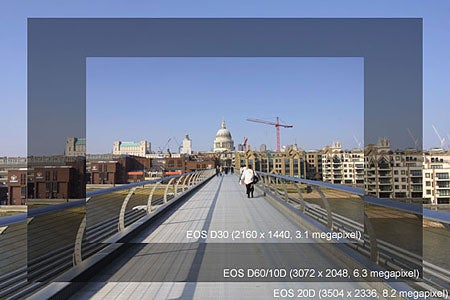
Verdict
Key Specifications
- Review Price: £936.00
Canon certainly doesn’t hang around when it comes to introducing new cameras – for instance it’s only been three years since I got my hands on the Canon EOS D30 – the company’s first compact digital SLR. Building on the success of that, and the subsequent D60 and 10D, the new EOS 20D has been designed with both serious amateur and professional photographers in mind. The 20D offers a significant number of improvements over its predecessors. These include Canon’s new DIGIC II imaging processor, a new Hi-Precision 9-point AF system, an impressive 5fps shooting speed, and a fast start-up time of 0.2 secs.
Probably the most notable change however is the newly developed 8.2 megapixel sensor that delivers images up to 3,504 x 2,336 pixels in size, in the same 3:2 aspect ratio as conventional 35mm film. As you can see from the image below the 20D offers a significant increase in sensor resolution compared to the 3.1 megapixel EOS D30, although the improvement relative to the D60 and 10D is rather more modest. At the end of the day however, owners of the 20D will have more pixels to play with when post-processing and cropping images, which for some will be a major advantage.
Straight out of the box, the 20D looks remarkably similar to the 10D that it replaces. Canon’s hallmark Quick Control Dial can still be found on the back panel alongside the main LCD screen. I must say, I was quite surprised to see that Canon has used the same 1.8in 118,000 pixel display that was used in the 10D, especially when you consider that its prosumer-orientated PowerShot Pro1 actually has a larger 2.0in display with 235,000 pixels. Thankfully, the 20D’s display does offer a 10X zoom playback facility, which certainly helps when checking the focus of shots. You can also scroll through the images while still viewing the magnified display, which I found to be particularly useful when trying to pick out the sharpest shot from a series of very similar images.
Along the top is the familiar LCD information panel (which can be backlit if required), main dial, and also the shooting mode dial that has the usual array of ‘Creative’ and fully automatic exposure programs to choose from. However, take a closer look and you’ll notice that the control layout has actually been altered slightly, including the addition of a new multi-controller ‘joystick’ on the back panel. Located just above the Quick Control Dial and within easy reach of your thumb, the main purpose of the multi-controller is to allow users to select one or all of the nine auto focus points quickly and easily. It can also be used for moving around magnified images (in eight directions) on the LCD display.
Like the 10D, the top, front and rear covers of the 20D’s body are constructed from magnesium alloy which helps give it a solid, more ‘professional’ feel. However, thanks to a redesigned body structure the 20D is actually slightly smaller and lighter than the 10D. It also feels well-balanced in the hand and the rubber-coated grip makes it quite comfortable to use over long periods.
The newly designed built-in flash unit can sync at 1/250sec or slower and now extends slightly higher than before to reduce the chances of red eye. The increased elevation also prevents a shadow being cast from the lens, although this can still occur when using some of the physically longer wide-angle lenses. The built-in flash also features Canon’s new E-TTL II flash system that utilises distance information from the lens in order to provide better metering.
So long as you’re not shooting in one of the Auto modes, pressing the flash button on the side of the camera will pop the flash up regardless of the light level. Otherwise, the flash will pop-up automatically when required. In use, its effective range is limited to just a few metres, so if you’re after more reach I’d suggest investing in a separate flashgun. The observant among you will also have noticed that the white Canon logo has been embossed into the front of the 20D’s flash unit rather than just being printed on – apparently inspired by the design of Canon’s famous F1 SLR camera from the 1970s. Whatever the motivation behind it, in my opinion it’s a stylish touch.
Hidden under the new recessed rubber seal on the left side of the camera body are the connectors for the optional remote shutter release, the PC terminal (flash sync), the video out and also the USB2.0 interface. On the right hand side of the body you’ll find the CompactFlash compartment, which is located just behind the hand grip.
At the base of the grip is the battery compartment that houses the new BP-511A Lithium-ion battery, and also the small CR2016 battery which maintains the camera’s date and time when the main battery is removed. The higher capacity BP-511A battery is rated at 1390mAh, which provides a longer battery life than the older 1100mAh BP-511 battery used in the earlier cameras. In practice I found the 20D’s battery life to be excellent. Despite frequent use of the LCD display to review and delete images, and the occasional use of the built-in flash, I could usually manage at least 500 shots before the low battery warning first appeared, and even then I could squeeze out another few hundred shots before it died.
The 20D’s menu is colour coded for the different menu categories: red for the Shooting menu, blue for the Playback menu and yellow for the Set-up menu. Navigation through the menus is straightforward and is carried out using the Quick Control Dial and Set button on the back of the camera. Also, by pressing the Jump button you can skip quickly to the first item of each menu category. It’s through the menu system that you gain access to the 20D’s numerous Custom Functions that allow you to tweak and customise various features according to your own preferences. One notable feature for example is that you can increase the 20D’s maximum sensitivity from ISO 1600 to ISO 3200 by enabling the ‘ISO expansion’ Custom Function. Of course the downside is that image noise will increase, but if you really need to get that shot then the extra stop of light could prove invaluable in difficult shooting conditions.
””’List of the EOS 20D’s “Custom Functions”””’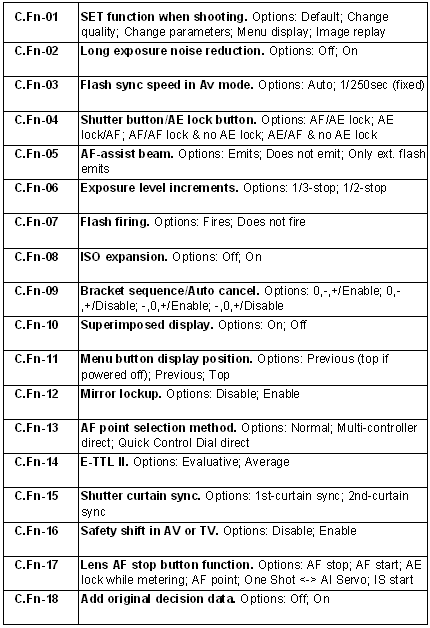
The 20D now has a maximum shutter speed of 1/8000sec, compared to 1/4000sec on the earlier models. When shooting continuously at 5fps, you can take up to 23 consecutive shots at the highest resolution JPEG setting. If shooting in RAW mode however, this drops down to a maximum burst of eight shots. Either way after a short wait for the 20D’s memory buffer to empty you’re then ready for another burst. It obviously helps here if you invest in a fast CF card, since it means less time is spent waiting for the queue of images to be transferred from the buffer. It is a pity however that the continuous shooting speed can’t be slowed down at all (to an intermediate setting of say 2.5fps), as quite often I found myself accidentally firing off three or four shots when all I wanted was one extra. Also, the shutter release sound is now slightly louder than before, which I guess is mainly due to the 20D’s new high-speed mirror mechanism.
Like the 10D before it, the 20D has an AF-Assist facility that relies on the built-in flash to fire a quick burst of flashes to enable easier auto focusing in low light conditions. By default, the camera will also fire a full flash as well, which may not always be wanted. However one of the Custom Functions on the 20D (which isn’t available on the 10D) will disable the flash unit but still allow AF-Assist. Although using the flash is more accurate than the dedicated AF lamp used on the older D30 and D60 models, the flash bursts can be quite obtrusive if, for example, you’re trying to shoot in a darkly lit museum that doesn’t allow flash photography. Thankfully, the 20D’s AF-Assist shouldn’t be required that often, because the new AF system does focus extremely well even in very low light or when shooting low contrast subjects.
The 20D offers three different auto focus modes – One-Shot for still subjects, AI Servo for moving subjects, and also an AI Focus mode that switches automatically from One-Shot to AI Servo if the subject starts moving. Naturally, if the shooting conditions limit the effectiveness of auto focusing then switching the lens to manual focus is always an option.
In addition to the default auto white balance setting, there’s a variety of preset white balance modes to choose from plus a custom white balance for calibration to a particular light source. There’s also a new white balance bracketing mode that with just one press of the shutter release will bracket each side of the standard white balance with either a blue/amber bias or a magenta/green bias – clever stuff indeed. Furthermore, the usual set of image processing parameters (contrast, sharpness, saturation, colour tone) are all still available, and are adjustable via the 20D’s menu system. There’s even a new Black & White mode complete with filter and toning effects such as sepia.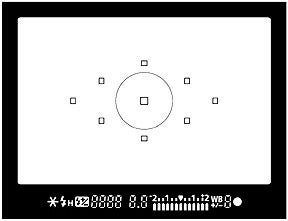
The viewfinder on the 20D is clear and has a comfortable rubber eyepiece with a dioptre adjustment wheel located on the top right corner. Looking through the viewfinder you’ll see the partial metering circle, as well as the nine illuminated auto focus points arranged in a diamond pattern. Along the bottom of the viewfinder is the illuminated status panel that displays the exposure information along with other settings, although annoyingly the ISO setting is not shown. To find that out you have to take your eye away from the viewfinder, refer back to the top LCD information panel and then press the ‘Drive-ISO’ button.
As far as bundled software goes, the 20D is supplied with several useful applications for both the PC and Mac, including the EOS Viewer Utility and a copy of Adobe Photoshop Elements 2.0. A copy of Canon’s Digital Photo Professional software is included too, which has been designed specifically for browsing and batch processing RAW image files.
For this review, I tested the 20D with Canon’s EF 17-40mm f/4 L, EF 85mm f/1.8 and EF 28mm f/2.8 lenses. Like its predecessors, the “effective” focal length of any lens on the 20D will be 1.6X greater than normal due to the smaller sensor size in comparison with standard 35mm film. For instance, a standard 300mm telephoto lens will effectively become an impressive 480mm lens when mounted on the 20D. The downside of this “field of view crop” is that it’s more difficult (and costly) to get a 35mm-equivalent super wide-angle lens. Fortunately, the 20D is Canon’s first digital SLR in its mid-range line-up to also offer support for the new range of EF-S lenses – previously only the entry-level EOS 300D offered EF-S compatibility.
The ‘S’ in EF-S stands for ‘short back focus’, which refers to the fact that the rear lens element is positioned closer than normal to the CMOS sensor. This apparently makes it cheaper and easier to produce wide-angle lenses for digital SLRs that have APS-C size sensors like the 20D. Although we didn’t have any EF-S lenses for this review, the 20D is available in kit-form with the EF-S 18-55mm f/3.5-5.6 lens. At the time of writing, there’s also an all-purpose EF-S 17-85mm f/4-5.6 (with Image Stabiliser) and a super wide-angle EF-S 10-22mm f/3.5-4.5 that can be purchased separately.
Image quality wise the 20D is nothing short of stunning. Colour rendition and image detail from the 20D are both particularly good, and thanks to the very low noise levels present at ISO 800 and below, images look surprisingly ‘clean’. Even at higher sensitivities, I found the additional noise to be quite tolerable in most shots, rarely detracting from the rest of the image. I also noticed that the 20D’s Evaluative metering system coped extremely well under difficult lighting conditions, resulting in almost every shot being correctly exposed – even those with extreme ranges of highlights and shadows. For those really tricky scenes however, there’s always the option of using Partial or Centre-weighted Average metering, although in my opinion there’s no excuse for omitting a true spot metering mode. That said, at the current asking price of £935.89 for the body only, the 20D offers very good value for money and having used it for the past few months I can honestly say that, despite one or two minor niggles, it’s a wonderful piece of kit.
”’Verdict”’
For those considering buying their first digital SLR, I would recommend the 20D without hesitation. The new Canon offers fantastic image quality, very low image noise at high sensitivity, and excellent build quality. Plus you get the support and choice of Canon’s EF (and EF-S) lens range, which is arguably one of the best. Similarly, if you own the older Canon D30 or D60 models, then the 20D will be a worthy upgrade although less so from the 10D. That said, I have no doubt the extra resolution, 5fps shooting speed, quicker start-up time and more responsive auto focusing will also prove tempting for some 10D owners.
”As of yet we do not have the facility to offer full-res downloads. This facility will be implemented in the next build of the web site. I’ve therefore had to reduce the size of the original images and/or produce 100% (i.e. 1:1) crop-outs, in order for you to get a true idea of the image quality. For all these test shots, the camera’s image processing parameters (contrast, sharpness, saturation and colour tone) were set to neutral. No additional sharpening has been applied for display on the web.”
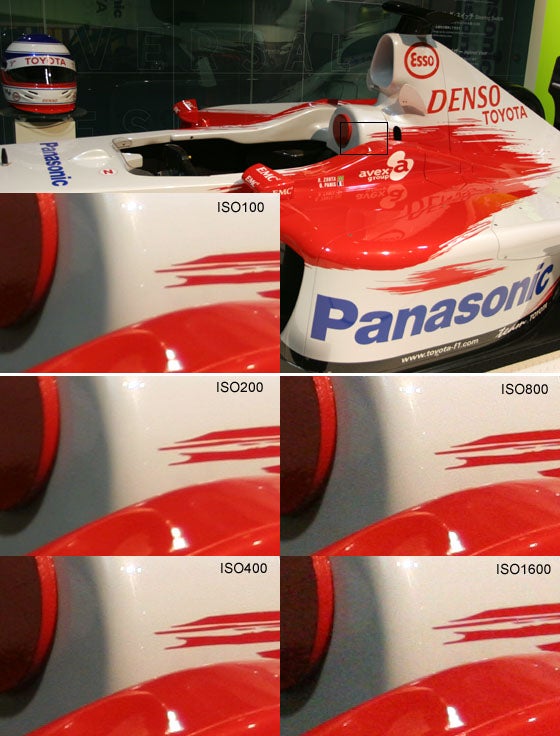
”’This montage demonstrates the 20D’s excellent low-noise characteristics. The five insets are 1:1 crops from the original image. The larger top image (not at full resolution) is there to give an indication of where the crop was taken. As you can see, noise only starts to become an issue at ISO 1600. (Shots taken indoors without flash).”’
”’As you can see from these series of shots, the 20D’s colour reproduction is extremely accurate and image definition is particularly good. In each example the top image has been reduced in size and the lower image is a 1:1 crop from the original. (All original images shot at 1/500sec, f/4, ISO 100)”’
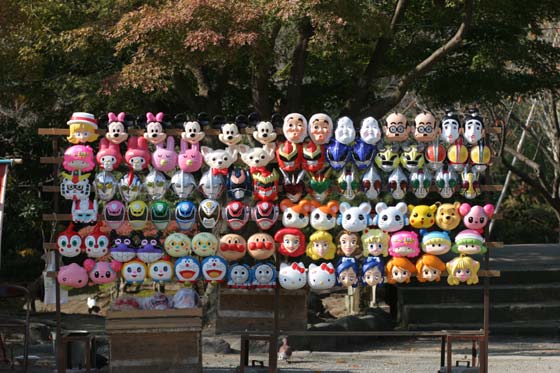

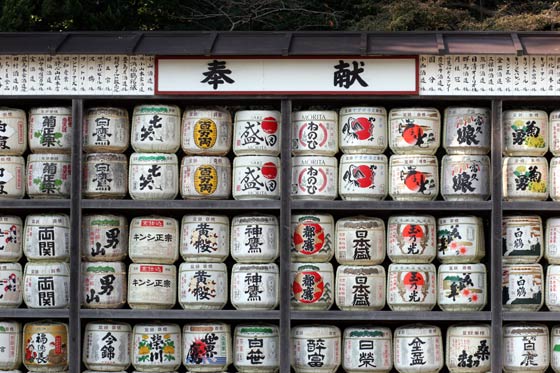

”’This shot was taken with the Evaluative metering mode selected, and is well exposed despite the combination of a dark foreground and backlit subject. The top image has been reduced in size and the lower image is a 1:1 crop from the original. (1/180sec, f/2.8, ISO 100).”’
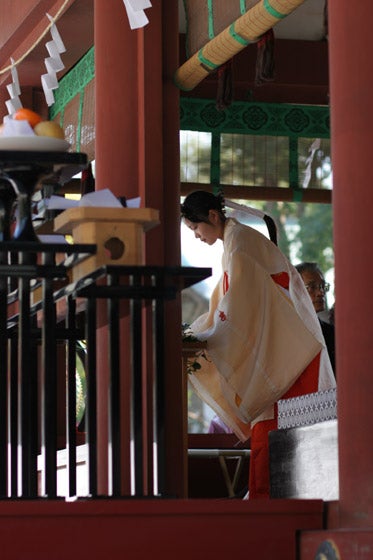
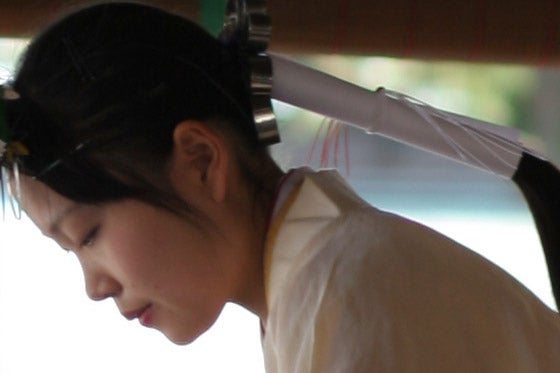
—-
”’This is another example of the 20D’s Evaluative metering doing a decent job with exposure. The wet pavement appears well lit and the bright illuminated shop signs haven’t been overexposed. The top image has been reduced in size and the lower image is a 1:1 crop from the original. (1/180sec, f/1.8, ISO 200).”’
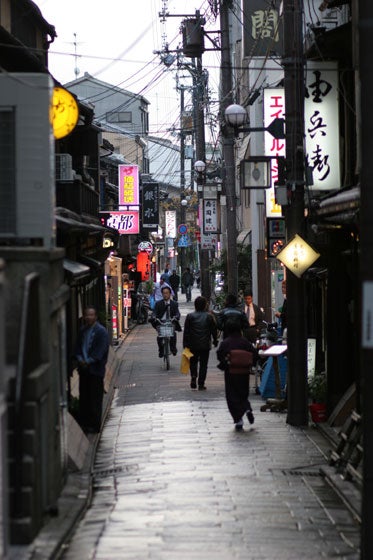
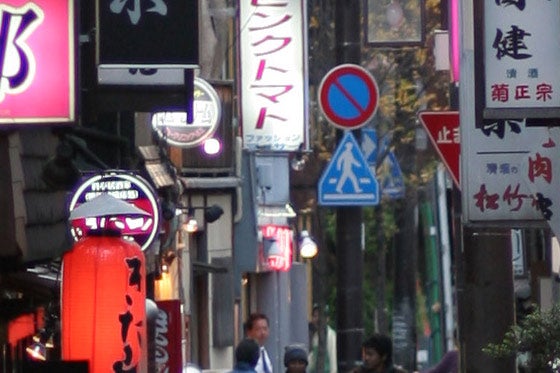
”’This image illustrates how the 20D is capable of accurately reproducing skin colour and tones. The top image has been reduced in size and the lower image is a 1:1 crop from the original. (1/350sec, f/3.5, ISO 200).”’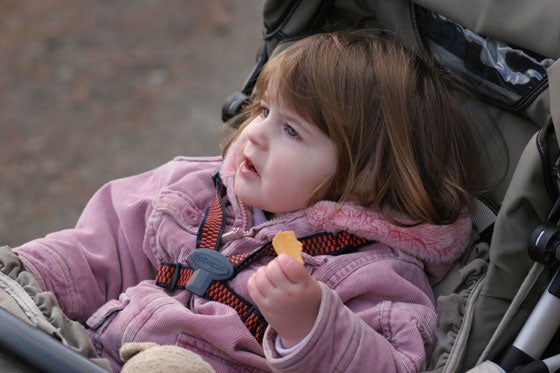
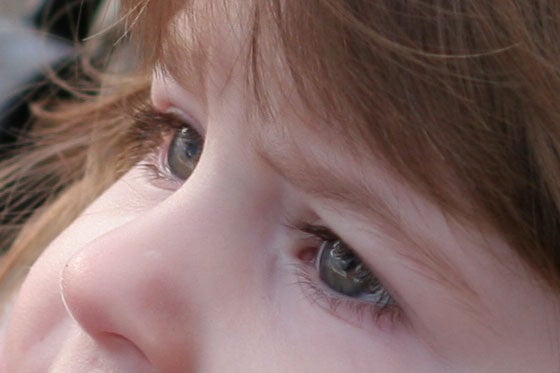
—-
”’To focus for this shot I selected the centre AF point only. The 20D’s accurate focusing (in relatively low light) was quick enough to allow me to pick the subject out from a busy crowd of moving people. The image has been reduced in size for the web. (1/125sec, f/1.8, ISO 200).”’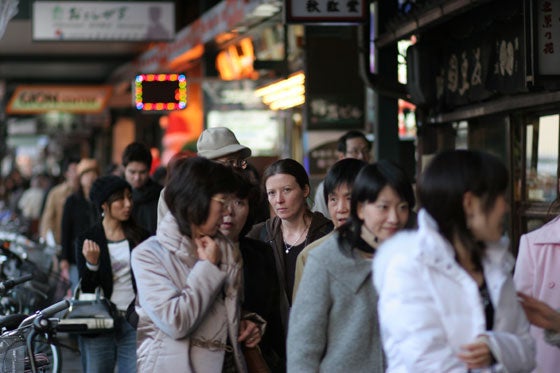
(table:spec)
Trusted Score
Score in detail
-
Value 9
-
Image Quality 10
Features
| Camera type | Digital SLR |
| Megapixels (Megapixel) | 8.3 Megapixel |
| Optical Zoom (Times) | By lensx |
| Image Sensor | CMOS |
| LCD Monitor | 1.8 in |
| Flash modes | Auto Flash, Red-eye Reduction |
| Memory card slot | CompactFlash (CF) Card |

